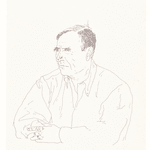David Hockney b. 1937
Christopher Isherwood, Santa Monica, 1968
signed with the artist's initials, titled and dated 1968
ink on paper
ink on paper
17 1/8 x 13 7/8 inches
43.2 x 35.2 cm
43.2 x 35.2 cm
David Hockney met Christopher Isherwood (1904 – 1986) in 1964, soon after moving to California, and he struck up a close friendship with Isherwood and his partner, the artist Don...
David Hockney met Christopher Isherwood (1904 – 1986) in 1964, soon after moving to California, and he struck up a close friendship with Isherwood and his partner, the artist Don Bachardy (b.1934), becoming a regular among the couple’s circle of friends, as his biographer, Christopher Sykes notes,
‘Isherwood’s diaries from this time show that Hockney led a social life that was every bit as relentless as his working life. At its centre was Isherwood and Don Bachardy’s house at 145 Adelaide Drive, Santa Monica, where they presided over a southern Californian salon for philosophers, writers and artists. At regular dinners held around their circular dining table, which came from a sale at the props department at Warner Bros, Hockney mixed with Aldous Huxley, Allen Ginsberg, the Stravinskys, Wystan Auden, Lauren Bacall and Tony Richardson.’ 1
Isherwood’s best-known novels, Mr Norris Changes Trains, 1935, and Goodbye to Berlin, 1939, were based on his experiences of
pre-war Germany. He emigrated to California to work as a Hollywood scriptwriter in 1939 and became a US citizen in 1946. Around the time he met Hockney, Isherwood was writing his last novel, A Meeting by the River, 1967, after which his writing focused on autobiography. In early 1968, Hockney found a place to rent close to Isherwood’s home. During the first half of the year, he worked on two double portraits: one of Isherwood and Bachardy sitting in their living room; the other of collectors Fred and Marcia Weisman standing outside by their pool. In preparation for his portrait of Isherwood and Bachardy, Hockney took photographs and made numerous drawings of the couple, including the present work.
Hockney’s portrait of Isherwood revels in the details of his buzz cut hair and bushy eyebrows, these areas of high detail contrasting with the more fluid lines of the sitter’s shirt. Hockney spoke of the difficulty of getting this kind of drawing right – he wouldn’t allow himself to sketch out the image in pencil first, but would launch straight in with ink, the unforgiving nature of the medium providing the ideal discipline to attune one’s eye and hand.
In 1976, Hockney revisited his double portrait of Isherwood and Bacardy, making a lithograph of the couple, with their original poses reversed, for his suite of prints titled Friends. In the early 1980s, the couple appear together again in a new series of photocollages.
1 Christopher Sykes, Hockney: The Biography, A Pilgrim’s Progress, Century, London, 2014, p27
‘Isherwood’s diaries from this time show that Hockney led a social life that was every bit as relentless as his working life. At its centre was Isherwood and Don Bachardy’s house at 145 Adelaide Drive, Santa Monica, where they presided over a southern Californian salon for philosophers, writers and artists. At regular dinners held around their circular dining table, which came from a sale at the props department at Warner Bros, Hockney mixed with Aldous Huxley, Allen Ginsberg, the Stravinskys, Wystan Auden, Lauren Bacall and Tony Richardson.’ 1
Isherwood’s best-known novels, Mr Norris Changes Trains, 1935, and Goodbye to Berlin, 1939, were based on his experiences of
pre-war Germany. He emigrated to California to work as a Hollywood scriptwriter in 1939 and became a US citizen in 1946. Around the time he met Hockney, Isherwood was writing his last novel, A Meeting by the River, 1967, after which his writing focused on autobiography. In early 1968, Hockney found a place to rent close to Isherwood’s home. During the first half of the year, he worked on two double portraits: one of Isherwood and Bachardy sitting in their living room; the other of collectors Fred and Marcia Weisman standing outside by their pool. In preparation for his portrait of Isherwood and Bachardy, Hockney took photographs and made numerous drawings of the couple, including the present work.
Hockney’s portrait of Isherwood revels in the details of his buzz cut hair and bushy eyebrows, these areas of high detail contrasting with the more fluid lines of the sitter’s shirt. Hockney spoke of the difficulty of getting this kind of drawing right – he wouldn’t allow himself to sketch out the image in pencil first, but would launch straight in with ink, the unforgiving nature of the medium providing the ideal discipline to attune one’s eye and hand.
In 1976, Hockney revisited his double portrait of Isherwood and Bacardy, making a lithograph of the couple, with their original poses reversed, for his suite of prints titled Friends. In the early 1980s, the couple appear together again in a new series of photocollages.
1 Christopher Sykes, Hockney: The Biography, A Pilgrim’s Progress, Century, London, 2014, p27
Provenance
Private CollectionPatricia McCallum and Michael York, acquired from the above c.1971
Exhibitions
Paris, Palais du Louvre, Musée des Arts Décoratifs, David Hockney: Paintings and Drawings, 11 October – 9 December 1974, cat no.55, p5, not illus



